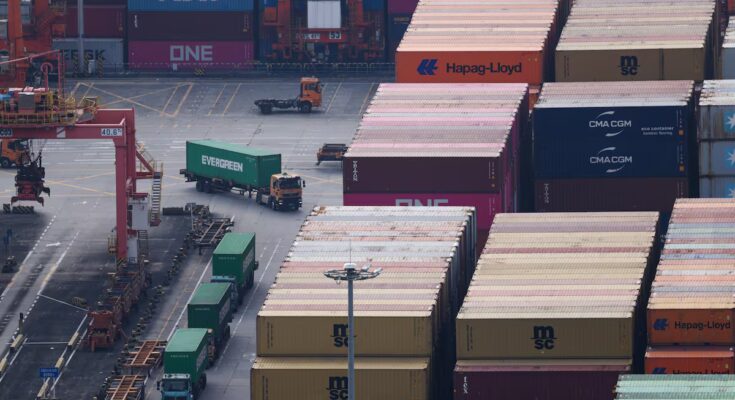China has begun to notice the effects of the trade war with the United States, six months after Donald Trump unleashed his global tariff storm. The dollar value of the Asian giant’s exports fell 1.1% year-on-year in October – in yuan terms the reduction was 0.8% – according to data released Friday by the General Administration of Customs. This is the first contraction since April, the month in which the American president announced its christening as “Liberation Day”, and contrasts sharply with the 8.3% increase recorded in September, the best figure in six months.
The first sign that trade tensions between the two giants are starting to weigh on the Asian giant’s economy took analysts by surprise, who expected growth of around 3%. The country’s GDP grew in the third quarter at its lowest rate in a year, 4.8%, compared with 5.4% in the first quarter and 5.2% in the second.
The recent decline in exports is partly because the artificial boost that supported them during the summer, when companies brought forward shipments to avoid tariffs, has worn off. Another factor to take into consideration is the appreciation of the yuan in recent weeks, which has made overseas sales more expensive and made Chinese products less competitive on international markets.
The long-awaited meeting between Trump and his Chinese counterpart, Xi Jinping, held last week in South Korea, culminated in an agreement to extend the trade truce between the two powers by a year, after weeks of cross-threats over China’s rare earth export controls and US restrictions on technology products. The pact, which provides for the partial reduction of some taxes and the temporary suspension of others, aims to reduce tensions in a year marked by volatility in bilateral trade. To be precise, rare earth exports increased by 75% between September and October, according to EFE calculations based on data released on Friday.
Although China’s overall sales to the United States have been steadily reduced in recent months (in October they fell by 25.2%, following a 27% decline in September), this decline in exports has so far been offset by an increase in shipments to the two regional blocs that top the rankings of trading partners, the Association of Southeast Asian Nations (ASEAN) and the European Union (EU).
But exports to the EU rose just 0.9% year-on-year in October, well below September’s 14.2% increase. The slowdown was also felt in Southeast Asia, where sales rose 11%, the slowest pace since February, and in Africa, where growth fell to 10.5% year-on-year, following September’s spectacular 56% rebound. For its part, in Latin America, they grew by a modest 2.1%, far from 15.2% in September, a slowdown that experts attribute to Mexico’s efforts to tighten controls on Chinese imports in the face of growing pressure from Washington.
Despite this setback, analysts cite the Hong Kong newspaper South China Morning Post They agree that foreign trade will continue to represent an essential support for the Chinese economy, which is facing an uneven recovery after the pandemic, marked by the crisis in the real estate market and the cooling of consumption.
For their part, imports increased 1% year-on-year, while remaining well below September’s 7.4% and forecast 4.5%. In October, China’s trade surplus amounted to $90 billion (€78 billion), which corresponds to a decrease of 5.69% year-on-year.



